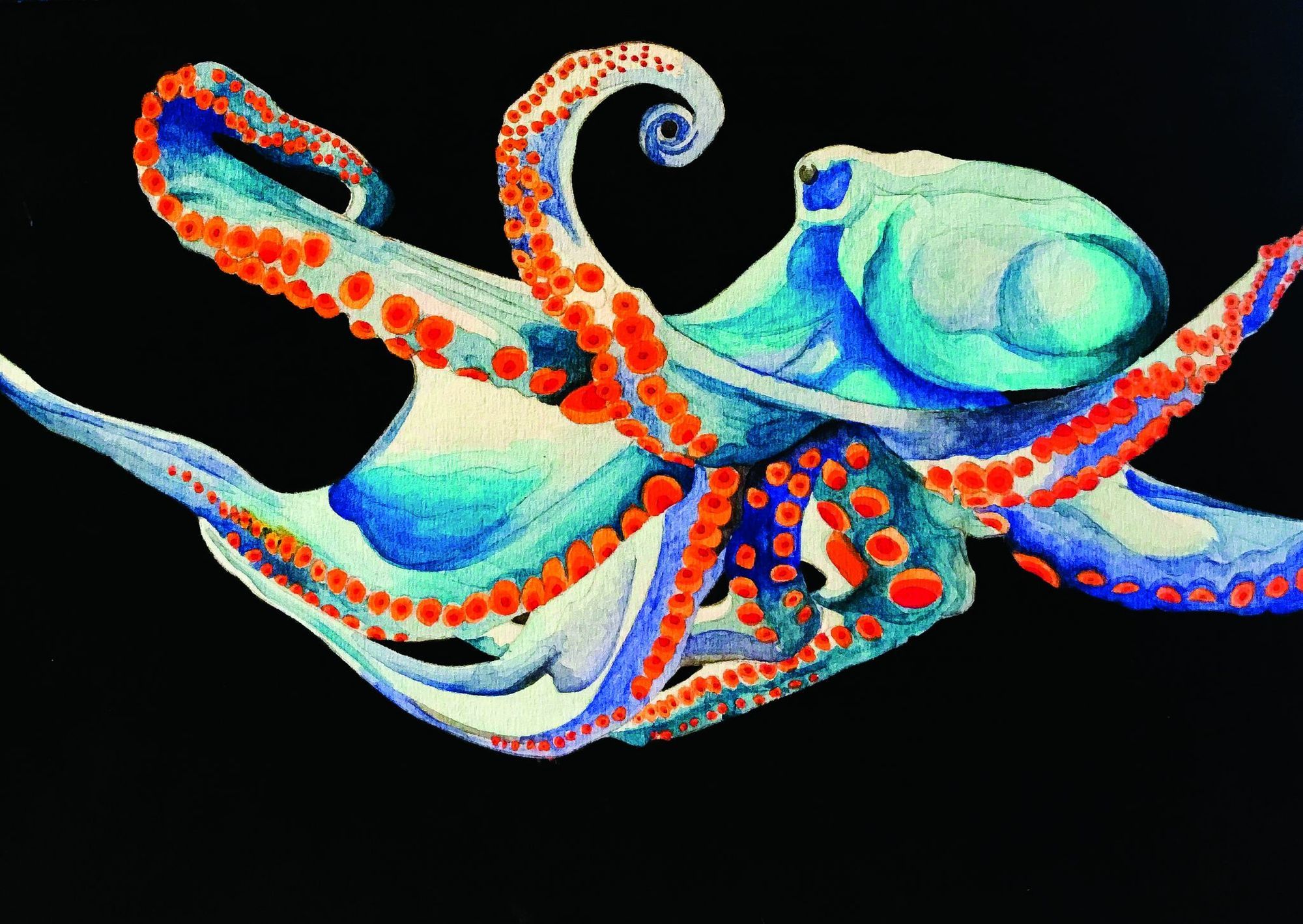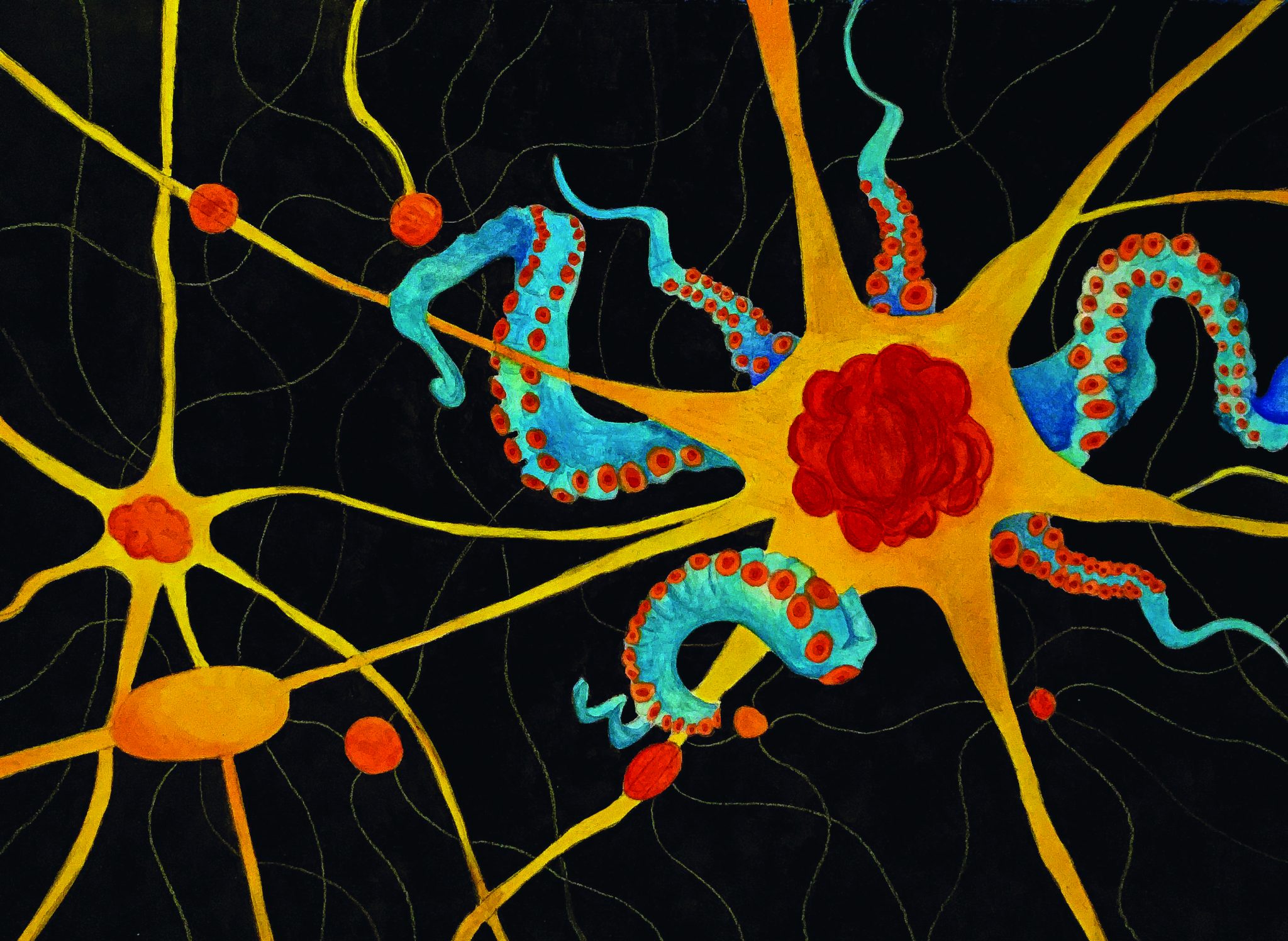Humans are intelligent beings capable of complex cognitive feats such as self-awareness. There are many existing and emerging theories proposing different explanations for this exceptional intelligence. A common strategy for understanding how intelligence arises is to study the nervous system of other animal models. One such animal is the octopus, a highly intelligent organism with cognitive abilities that, by certain measures, match or exceed those of some mammals [1]. For example, octopuses can recognize faces, recognize themselves, and learn through observation [2][3][4]. Interestingly, our last common ancestor with the octopus was likely a flattened, worm-like creature with a simple nervous system, incapable of advanced cognitive abilities [5]. This indicates that octopus intelligence evolved more or less independently from vertebrate intelligence, and similarities between the octopus’s nervous system and our own are not likely due to our shared ancestor. For this reason, the octopus provides a useful model for investigating how the general mechanisms of intelligence arose [6].
Octopuses, squid, and cuttlefish all belong to a class of marine mollusks called cephalopods. The common octopus, Octopus vulgaris, has about 500 million neurons [5]. This absolute number of neurons is comparable to that of frogs (~16 million) and small mammals such as the mouse (~50 million) and rat (~100 million). Furthermore, aside from the absolute size of the nervous system, the relative size of the octopus’s nervous system to its body size is notable as well. The nervous system is energetically expensive and measuring the cost of maintaining it is a good indicator of how important it may be to the animal’s survival. The relative size of the octopus’s nervous system to its body is similar to vertebrate nervous systems—smaller than those of birds and mammals but larger than those of fish and reptiles. Although this similarity to some mammals is enticing and may suggest some sort of higher cognitive ability in the octopus, it is still only a correlation and not a definite measure of intelligence. Scientists are still investigating the relationship between the nervous system’s absolute and relative size and the complexity of behavior and intelligence [5].
Learning and Memory Systems in the Octopus
In 2010, biologist Roland C. Anderson and his colleagues at the Seattle Aquarium tested for recognition capabilities in eight giant Pacific octopuses. Their experiment involved two types of keepers: a “nice” keeper who regularly fed the octopuses and a “mean” keeper who touched them with a bristly stick [2]. After two weeks, all the octopuses behaved differently toward the two keepers, particularly in their movements toward or away from the feeding apparatus. Since the keepers were wearing identical uniforms, this confirmed the octopuses’ ability to distinguish among individual people through learned visual information [2]. In addition, the octopuses were able to remember the keepers’ faces and use this information to govern their future behavior, highlighting the octopuses’ memory capabilities.
In the octopus brain, the primary structure involved in learning and memory is the vertical lobe (VL) system [7]. Experiments in which the VL is removed have shown severe impairments to observational learning and longterm memory recall [4]. The VL system consists of the VL and medial superior frontal lobe (MSF). The VL receives visual input primarily from the MSF in a large fiber bundle called the MSF tract. Within the VL, interneurons innervate this MSF tract in a regular fashion, forming what’s called an association matrix, similar to that of the vertebrate hippocampus [8][7].
In mammals, the hippocampus is an area of the brain that is strongly associated with learning and memory. One of the current theories on how learning arises here is called longterm potentiation (LTP) and long-term depression (LTD). LTP and LTD result from the persistent strengthening or weakening of synapses based on recent patterns of activity [9]. These patterns of activity result in long lasting increases (LTP) or decreases (LTD) in the signal transmission between two neurons and are the basis for synaptic plasticity [10].
A study conducted by Binyamin Hochner and his research team at the Hebrew University of Jerusalem found a similar LTP mechanism in the VL of octopuses [7]. With repeated high frequency stimulation to the presynaptic neurons in the MSF, researchers were able to induce increased electrical responses in the postsynaptic cells of the VL. They found that in order to induce LTP, the excitatory signal must occur at a high enough frequency and amplitude, which is unlikely to be achieved from the activity of one presynaptic cell. This finding suggests that LTP requires the cooperative activation of a minimal group of MSF fibers and likely the recruitment of more MSF fibers. Altogether, this provides a potential mechanism for associative learning in the octopus brain [7].
To explain, say your mom calls you ten times to buy bananas from the store, but you’re lazy and don’t do as she asks. Now say your dad and your mom call you repeatedly at the same time and both want you to buy bananas. You respond immediately and are likely to respond more promptly because both parents called you. In addition, you know that both your mom and dad want bananas. This is analogous to the recruitment of more MSF fibers, where the VL will not respond unless multiple fibers (i.e. both parents) fire at a high frequency (i.e. repeated calls) and amplitude. In addition, like the association of your mom and dad both requesting bananas, the information that each presynaptic neuron carries is associated with the same postsynaptic neuron. This type of plasticity is also known as Hebbian type synaptic plasticity—“neurons that fire together, wire together" [7]. The discovery of LTP in octopuses provides evidence for convergent evolution that has led to the selection of similar synaptic activity. Though not yet agreed upon in the scientific community, the existence of LTP in both mammals and octopuses strengthens the concept of LTP as a cellular basis for learning and memory and may be a general mechanism for associative learning [7].

To study if LTP played a role in octopus behavior, Hochner’s team investigated how stimulating or severing the VL affected the learning of a passive avoidance task [11]. The task involved pre-training the octopuses to learn that attacking a white ball resulted in a food reward. Then during the test, the octopuses were presented with a red ball that resulted in a shock. The stimulated octopuses demonstrated accelerated short-term learning and avoided the red ball significantly earlier than the sham-treated controls. On the other hand, the octopuses with severed VLs showed slowed short-term memory acquisition. Both treatment groups showed impaired long-term recall the next day. These results suggest that long-term memory and short-term memory sites are separated in the octopus brain, similar to mammals, but they are not independent. The researchers concluded that the VL is involved in the control of behavior and short-term memory and mediates long-term memory acquisition via LTP [11].
Recall, LTP/LTD may underlie a form of associative learning in the mammalian hippocampus. This suggests that the analogous structure in the octopus, the VL system, may underlie the associative learning observed in the passive avoidance task via the LTP/LTD-like mechanism. The convergent evolution of LTP/LTD-like mechanisms and associative learning ability in both mammals and octopuses suggests that an LTP/LTD mechanism may be a general mechanism for associative learning in the nervous system. Additional studies are necessary to investigate whether other cases of associative learning in nature are also produced by a similar LTP/LTD mechanism.
So Where Does This Intelligence Come From?
A team of scientists led by Joshua Rosenthal of the Marine Biological Laboratory found that unlike other invertebrates, octopuses and their relative cephalopods exhibited a type of gene alteration called RNA editing [12]. The most common RNA modification is adenosine deamination, in which an adenine base is modified and recognized as a different nucleotide base during translation. This means that adenosine deamination has the capacity to change protein structure and function. Cell function is governed by its protein composition; thus, this form of editing can have wide implications for the cell and the traits of the organism. These traits can then be selected for during natural selection, which drives much of evolution. In addition, the majority of edits have been observed in neurons and disproportionately affect proteins involved in the nervous system, such as ion channels [12]. Edits were dramatically less frequent in the nautilus, the earliest lineage of cephalopod, compared to its intellectually advanced relatives: the octopus, squid and cuttlefish [9]. This finding suggests that the RNA edits may be the origin of their high cognitive ability. However, only a correlation has been identified, and the exact origins of cephalopod intelligence are uncertain without more research [9].
Scientists think that editing at the RNA level allows these advanced cephalopods to flexibly adapt to their environment, despite their slowly changing genome [9]. By editing RNA, the same gene can produce multiple types of proteins. Normally, without RNA editing, protein diversity relies on random genetic mutations in the genome, which must then be selected for over generations to propagate in the population. Protein diversification by this process is inefficient and occurs much more slowly than by RNA editing. Thus, in the octopus, squid and cuttlefish, the expansion and diversity of proteins achieved through RNA editing may have allowed for faster evolution and selection for favorable proteins. These favorable proteins may have supported traits such as greater intellectual capacity, providing a selective advantage for the octopus in its environment [9].

During evolution, however, the propagation of genetic material provides the basis for inheritance. So how are the favorable RNA edits passed on to progeny? Scientists are unsure at this point and continue to speculate about potential explanations. Researchers suggest the next step is to investigate the function of the RNA editing enzymes in these cephalopods; perhaps the RNA edits are inherited via the genes for the RNA editing enzymes [9].
The octopus is an incredible creature capable of stunning cognitive abilities. Its intelligence arose from a different evolutionary history than ours, making the octopus a promising model from which to study general intelligence. At a network level, the octopus’s learning and memory may be related to LTP, a process that evolutionarily and developmentally may be derived from a complex RNA editing process. Understanding the organization and function of the octopus nervous system may help us understand how learning and memory work to create intelligence in many species, our own included.
References
- Hochner, B. (2012). An Embodied View of Octopus Neurobiology. Current Biology , 22 (20), R887–R892.
- Anderson, R. C., Mather, J. A., Monette, M. Q., & Zimsen, S. R. M. (2010). Octopuses (Enteroctopus dofleini) recognize individual humans. Journal of Applied Animal Welfare Science: JAAWS , 13 (3), 261–272.
- Tricarico, E., Borrelli, L., Gherardi, F., & Fiorito, G. (2011). I Know My Neighbour: Individual Recognition in Octopus vulgaris. PLoS ONE , 6 (4).
- Fiorito, G., & Scotto, P. (1992). Observational Learning in Octopus vulgaris. Science , 256 (5056), 545–547.
- Hochner, B. (2008). Octopuses. Current Biology , 18 (19), R897–R898.
- Hochner, B., Shomrat, T., & Fiorito, G. (2006). The octopus: a model for a comparative analysis of the evolution of learning and memory mechanisms. The Biological Bulletin , 210 (3), 308–317.
- Hochner, B., Brown, E. R., Langella, M., Shomrat, T., & Fiorito, G. (2003). A Learning and Memory Area in the Octopus Brain Manifests a Vertebrate-Like Long-Term Potentiation. Journal of Neurophysiology , 90 (5), 3547–3554.
- Roth, G. (2015). Convergent evolution of complex brains and high intelligence. Philosophical Transactions of the Royal Society B: Biological Sciences , 370 (1684).
- Liscovitch-Brauer, N., Alon, S., Porath, H. T., Elstein, B., Unger, R., Ziv, T., … Eisenberg, E. (2017). Trade-off between Transcriptome Plasticity and Genome Evolution in Cephalopods. Cell , 169 (2), 191–202.e11.
- Purves, D., Augustine, G. J., Fitzpatrick, D., Katz, L. C., LaMantia, A.-S., McNamara, J. O., & Williams, S. M. (2001). Long-Term Synaptic Potentiation.
- Shomrat, T., Zarrella, I., Fiorito, G., & Hochner, B. (2008). The Octopus Vertical Lobe Modulates Short-Term Learning Rate and Uses LTP to Acquire Long-Term Memory. Current Biology , 18 (5), 337–342.
- Rosenthal, J. J. C., & Seeburg, P. H. (2012). A-to-I RNA Editing: Effects on Proteins Key to Neural Excitability. Neuron , 74 (3), 432–439.
